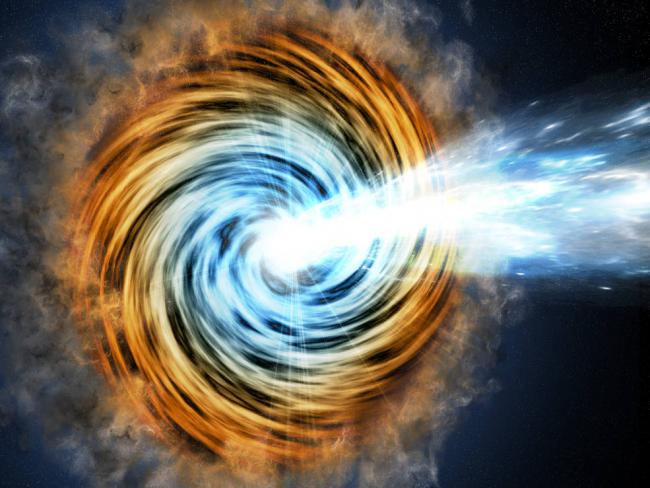
An artist's conception of a blazar, the most common type of source detected by NASA's Fermi gamma-ray spacecraft. Associating a bright gamma-ray source with a blazer is difficult, however, because the Fermi beam is large and encompasses many possible sources. Astronomers have developed a new statistical algorithm that finds most likely associations based on comparisons with objects' infrared and radio emission.
A blazar is a galaxy whose central nucleus is bright across the spectrum, from low energy radio wavelengths to the high energy gamma rays like those observed by the Fermi Gamma Ray Space Telescope. Astronomers think that a blazar nucleus contains a supermassive black hole that powers jets of charged particles as matter falls into its vicinity. Although the nuclei of other galaxies also eject jets of particles, the class of blazars is thought to result from our unique viewing angle: staring almost directly down the throats of the jets. Two defining characteristics of blazars,strong radio emission and high variability, are the results of the accretion and jets.
As Fermi surveys the sky it spots many powerful gamma-ray sources, but their locations are very uncertain, as much as twice the angular size of the moon, making it difficult to use the spatial location to identify any individual galaxy (or other obejct) as being responsible for the emission. Instead, indirect arguments are made from similarities of brightness, variability, and/or other inferences. Astronomers think that many of these sources should be blazars, and the most recent catalog of about 5100 sources has about 3000 blazars, but one quarter of the sources still lack any clear counterpart.
CfA astronomer Raffaele D'Abrusco was a member of a team that developed a new statistical method to associate Fermi gamma-ray sources with optical, infrared or radio counterparts. The Likelihood Ratio (LR) method, often used to identify counterparts of high energy sources, has typically relied on angular separation in a geometrical approach to calculate associating probabilities of the counterparts. The new version of this method builds instead on fluxes and colors from infrared and radio sky surveys. Infrared surveys have been instrumental in the discovery (made by the same team of researchers) that gamma-ray detected blazars have unique infrared colors that clearly distinguish them from other extragalactic sources. The new procedure takes advantage of these strong correlations between infrared colors and gamma-ray spectral properties of known blazars.
When applied to the approximately one thousand unassociated Fermi sources with possible infrared counterparts, the method identified 743 new associations with a better than 99% certainty, significantly increasing the number of gamma-ray blazars with likely low energy counterparts. The association will allow the final confirmation of the nature of these candidate blazars through optical spectra. The increase in the number of confirmed gamma-ray blazars is used in investigations of the engines that create the relativistic jets in blazars, helping to constrain the demographics of this elusive class of active galactic nuclei.
Reference(s):
"On the Physical Association of Fermi-LAT Blazars with Their Low-energy Counterparts," Raniere de Menezes, Raffaele D'Abrusco, Francesco Massaro, Dario Gasparrini, and Rodrigo Nemmen, The Astrophysical Journal Supplement Series 248, 23, 2020.